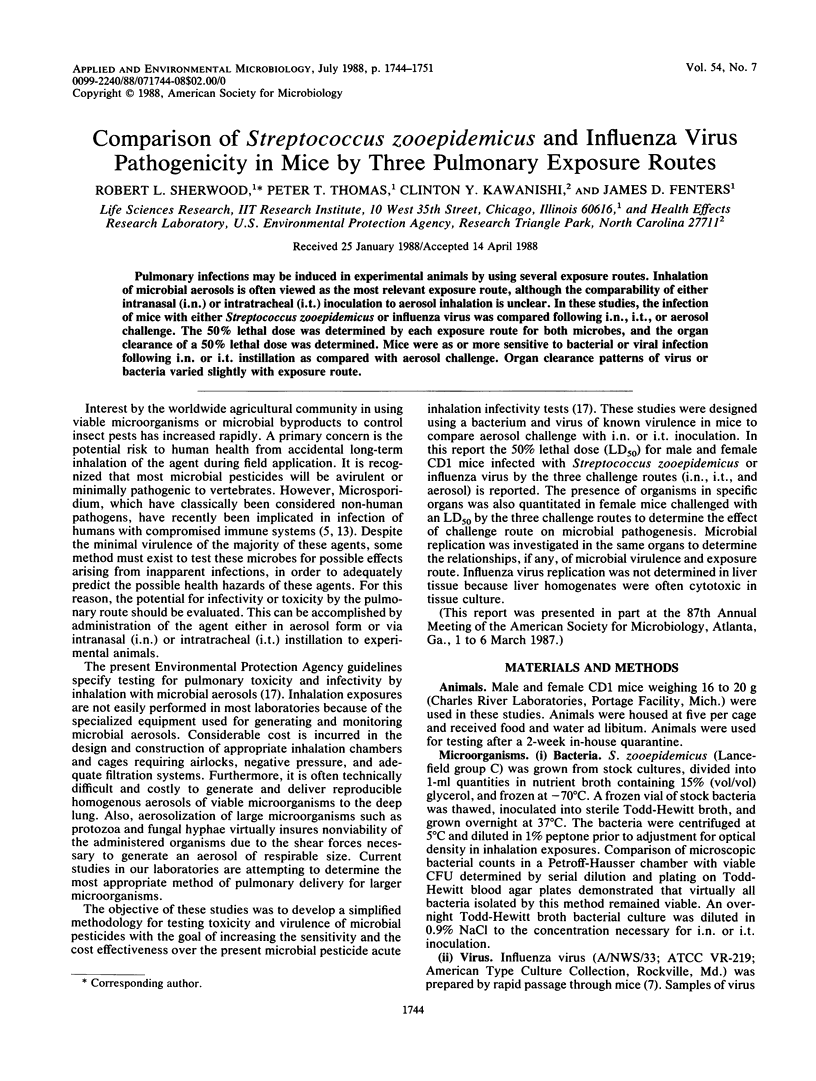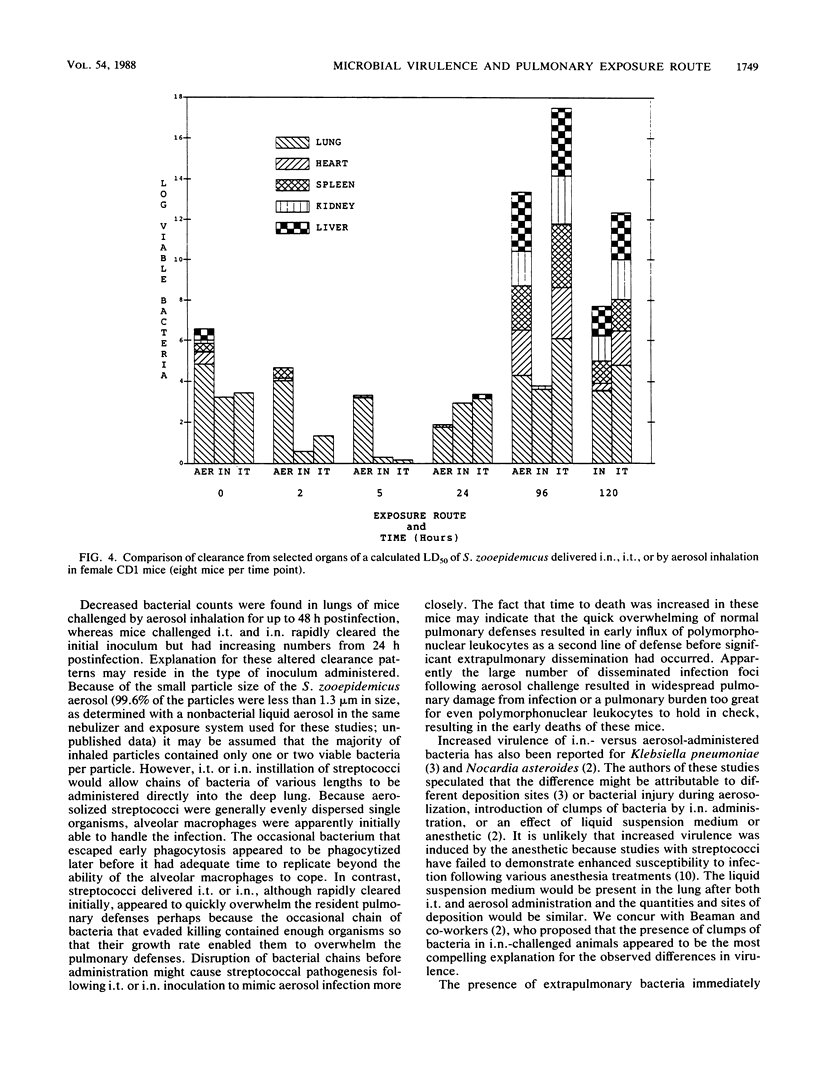Abstract
Pulmonary infections may be induced in experimental animals by using several exposure routes. Inhalation of microbial aerosols is often viewed as the most relevant exposure route, although the comparability of either intranasal (i.n.) or intratracheal (i.t.) inoculation to aerosol inhalation is unclear. In these studies, the infection of mice with either Streptococcus zooepidemicus or influenza virus was compared following i.n., i.t., or aerosol challenge. The 50% lethal dose was determined by each exposure route for both microbes, and the organ clearance of a 50% lethal dose was determined. Mice were as or more sensitive to bacterial or viral infection following i.n. or i.t. instillation as compared with aerosol challenge. Organ clearance patterns of virus or bacteria varied slightly with exposure route.
Full text
PDF







Selected References
These references are in PubMed. This may not be the complete list of references from this article.
- Appleyard G., Maber H. B. Plaque formation by influenza viruses in the presence of trypsin. J Gen Virol. 1974 Dec;25(3):351–357. doi: 10.1099/0022-1317-25-3-351. [DOI] [PubMed] [Google Scholar]
- Beaman B. L., Goldstein E., Gershwin M. E., Maslan S., Lippert W. Lung response to congenitally athymic (nude), heterozygous, and Swiss Webster mice to aerogenic and intranasal infection by Nocardia asteroides. Infect Immun. 1978 Dec;22(3):867–877. doi: 10.1128/iai.22.3.867-877.1978. [DOI] [PMC free article] [PubMed] [Google Scholar]
- Berendt R. F. Relationship of method of administration to respiratory virulence of Klebsiella pneumoniae for mice and squirrel monkeys. Infect Immun. 1978 May;20(2):581–583. doi: 10.1128/iai.20.2.581-583.1978. [DOI] [PMC free article] [PubMed] [Google Scholar]
- Desportes I., Le Charpentier Y., Galian A., Bernard F., Cochand-Priollet B., Lavergne A., Ravisse P., Modigliani R. Occurrence of a new microsporidan: Enterocytozoon bieneusi n.g., n. sp., in the enterocytes of a human patient with AIDS. J Protozool. 1985 May;32(2):250–254. doi: 10.1111/j.1550-7408.1985.tb03046.x. [DOI] [PubMed] [Google Scholar]
- Fenters J. D., Bradof J. N., Aranyi C., Ketels K., Ehrlich R., Gardner D. E. Health effects of long-term inhalation of sulfuric acid mist-carbon particle mixtures. Environ Res. 1979 Aug;19(2):244–257. doi: 10.1016/0013-9351(79)90052-5. [DOI] [PubMed] [Google Scholar]
- GREEN G. M., KASS E. H. FACTORS INFLUENCING THE CLEARANCE OF BACTERIA BY THE LUNG. J Clin Invest. 1964 Apr;43:769–776. doi: 10.1172/JCI104961. [DOI] [PMC free article] [PubMed] [Google Scholar]
- Gaush C. R., Smith T. F. Replication and plaque assay of influenza virus in an established line of canine kidney cells. Appl Microbiol. 1968 Apr;16(4):588–594. doi: 10.1128/am.16.4.588-594.1968. [DOI] [PMC free article] [PubMed] [Google Scholar]
- Hatch G. E., Slade R., Boykin E., Hu P. C., Miller F. J., Gardner D. E. Correlation of effects of inhaled versus intratracheally injected males on susceptibility to respiratory infection in mice. Am Rev Respir Dis. 1981 Aug;124(2):167–173. doi: 10.1164/arrd.1981.124.2.167. [DOI] [PubMed] [Google Scholar]
- Huprikar J., Rabinowitz S. A simplified plaque assay for influenza viruses in Madin-Darby kidney (MDCK) cells. J Virol Methods. 1980;1(2):117–120. doi: 10.1016/0166-0934(80)90020-8. [DOI] [PubMed] [Google Scholar]
- Larson E. W., Dominik J. W., Rowberg A. H., Higbee G. A. Influenza virus population dynamics in the respiratory tract of experimentally infected mice. Infect Immun. 1976 Feb;13(2):438–447. doi: 10.1128/iai.13.2.438-447.1976. [DOI] [PMC free article] [PubMed] [Google Scholar]
- Ledford D. K., Overman M. D., Gonzalvo A., Cali A., Mester S. W., Lockey R. F. Microsporidiosis myositis in a patient with the acquired immunodeficiency syndrome. Ann Intern Med. 1985 May;102(5):628–630. doi: 10.7326/0003-4819-102-5-628. [DOI] [PubMed] [Google Scholar]
- Sherwood R. L., Lippert W. E., Tarkington B., Goldstein E. Effect of ferrous sulfate aerosols and nitrogen dioxide on murine pulmonary defense. Arch Environ Health. 1981 May-Jun;36(3):130–135. doi: 10.1080/00039896.1981.10667616. [DOI] [PubMed] [Google Scholar]
- Snyder M. H., Stephenson E. H., Young H., York C. G., Tierney E. L., London W. T., Chanock R. M., Murphy B. R. Infectivity and antigenicity of live avian-human influenza A reassortant virus: comparison of intranasal and aerosol routes in squirrel monkeys. J Infect Dis. 1986 Oct;154(4):709–711. doi: 10.1093/infdis/154.4.709. [DOI] [PubMed] [Google Scholar]
- Sweet C., Macartney J. C., Bird R. A., Cavanagh D., Collie M. H., Husseini R. H., Smith H. Differential distribution of virus and histological damage in the lower respiratory tract of ferrets infected with influenza viruses of differing virulence. J Gen Virol. 1981 May;54(Pt 1):103–114. doi: 10.1099/0022-1317-54-1-103. [DOI] [PubMed] [Google Scholar]


